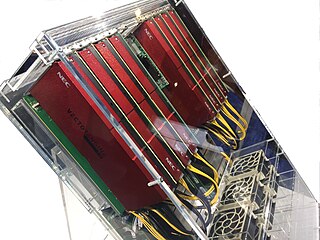Related Research Articles
Routing is the process of selecting a path for traffic in a network or between or across multiple networks. Broadly, routing is performed in many types of networks, including circuit-switched networks, such as the public switched telephone network (PSTN), and computer networks, such as the Internet.

A network interface controller is a computer hardware component that connects a computer to a computer network.
Alliant Computer Systems was a computer company that designed and manufactured parallel computing systems. Together with Pyramid Technology and Sequent Computer Systems, Alliant's machines pioneered the symmetric multiprocessing market. One of the more successful companies in the group, over 650 Alliant systems were produced over their lifetime. The company was hit by a series of financial problems and went bankrupt in 1992.

The RapidIO architecture is a high-performance packet-switched interconnect technology. RapidIO supports messaging, read/write and cache coherency semantics. RapidIO fabrics guarantee in-order packet delivery, enabling power- and area- efficient protocol implementation in hardware. Based on industry-standard electrical specifications such as those for Ethernet, RapidIO can be used as a chip-to-chip, board-to-board, and chassis-to-chassis interconnect. The protocol is marketed as: RapidIO - the unified fabric for Performance Critical Computing, and is used in many applications such as Data Center & HPC, Communications Infrastructure, Industrial Automation and Military & Aerospace that are constrained by at least one of size, weight, and power (SWaP).
In computing, a solution stack or software stack is a set of software subsystems or components needed to create a complete platform such that no additional software is needed to support applications. Applications are said to "run on" or "run on top of" the resulting platform.
Veritas Cluster Server is a high-availability cluster software for Unix, Linux and Microsoft Windows computer systems, created by Veritas Technologies. It provides application cluster capabilities to systems running other applications, including databases, network file sharing, and electronic commerce websites.
In computing, ioctl is a system call for device-specific input/output operations and other operations which cannot be expressed by regular system calls. It takes a parameter specifying a request code; the effect of a call depends completely on the request code. Request codes are often device-specific. For instance, a CD-ROM device driver which can instruct a physical device to eject a disc would provide an ioctl request code to do that. Device-independent request codes are sometimes used to give userspace access to kernel functions which are only used by core system software or still under development.
The Open Source Geospatial Foundation (OSGeo), is a non-profit non-governmental organization whose mission is to support and promote the collaborative development of open geospatial technologies and data. The foundation was formed in February 2006 to provide financial, organizational and legal support to the broader Free and open-source geospatial community. It also serves as an independent legal entity to which community members can contribute code, funding and other resources.

The Better Approach To Mobile Adhoc Networking (B.A.T.M.A.N.) is a routing protocol for multi-hop mobile ad hoc networks which is under development by the German "Freifunk" community and intended to replace the Optimized Link State Routing Protocol (OLSR).

The Linux Foundation (LF) is a non-profit technology consortium founded in 2000 as a merger between Open Source Development Labs and the Free Standards Group to standardize Linux, support its growth, and promote its commercial adoption. It also hosts and promotes the collaborative development of open source software projects.
In computing, Microsoft's Windows Vista and Windows Server 2008 introduced in 2007/2008 a new networking stack named Next Generation TCP/IP stack, to improve on the previous stack in several ways. The stack includes native implementation of IPv6, as well as a complete overhaul of IPv4. The new TCP/IP stack uses a new method to store configuration settings that enables more dynamic control and does not require a computer restart after a change in settings. The new stack, implemented as a dual-stack model, depends on a strong host-model and features an infrastructure to enable more modular components that one can dynamically insert and remove.
The Berkeley Packet Filter (BPF) is a technology used in certain computer operating systems for programs that need to, among other things, analyze network traffic. It provides a raw interface to data link layers, permitting raw link-layer packets to be sent and received. It is available on most Unix-like operating systems. In addition, if the driver for the network interface supports promiscuous mode, it allows the interface to be put into that mode so that all packets on the network can be received, even those destined to other hosts.

Node.js is an open-source, cross-platform, back-end JavaScript runtime environment that executes JavaScript code outside a web browser. Node.js lets developers use JavaScript to write command line tools and for server-side scripting—running scripts server-side to produce dynamic web page content before the page is sent to the user's web browser. Consequently, Node.js represents a "JavaScript everywhere" paradigm, unifying web-application development around a single programming language, rather than different languages for server-side and client-side scripts.
In digital communications networks, packet processing refers to the wide variety of algorithms that are applied to a packet of data or information as it moves through the various network elements of a communications network. With the increased performance of network interfaces, there is a corresponding need for faster packet processing.

A network scheduler, also called packet scheduler, queueing discipline, qdisc or queueing algorithm, is an arbiter on a node in packet switching communication network. It manages the sequence of network packets in the transmit and receive queues of the network interface controller. There are several network schedulers available for the different operating systems, that implement many of the existing network scheduling algorithms.
The Data Plane Development Kit (DPDK) is an Open source software project managed by the Linux Foundation. It provides a set of data plane libraries and network interface controller polling-mode drivers for offloading TCP packet processing from the operating system kernel to processes running in user space. This offloading achieves higher computing efficiency and higher packet throughput than is possible using the interrupt-driven processing provided in the kernel.
Eclipse Deeplearning4j is the only deep learning programming library written in Java for the Java virtual machine (JVM). It is a framework with wide support for deep learning algorithms. Deeplearning4j includes implementations of the restricted Boltzmann machine, deep belief net, deep autoencoder, stacked denoising autoencoder and recursive neural tensor network, word2vec, doc2vec, and GloVe. These algorithms all include distributed parallel versions that integrate with Apache Hadoop and Spark.
POWER10 is a superscalar, multithreading, symmetric multiprocessors based on the open source Power ISA announced in August 2020 at the Hot Chips conference. The processor is designed with 16 cores, but with only 15 cores available due to yield issues; this makes more processors available since they do not need to be fully functional to pass testing. The POWER10-based processors are being manufactured by Samsung using a 7 nm process with 18 layers of metal and 18 billion transistors. The silicon die is 602 mm2 large.

The NEC SX-Aurora TSUBASA is a vector processor of the NEC SX architecture family. Unlike previous SX supercomputers, the SX-Aurora TSUBASA is provided as a PCIe card, termed by NEC as a "Vector Engine" (VE). Eight VE cards can be inserted into a vector host (VH) which is typically a x86-64 server running the Linux operating system. The product has been announced in a press release on October 25 2017 and NEC has started selling it in February 2018. The product succeeds the SX-ACE.
Secure Reliable Transport (SRT) is an open source video transport protocol that utilises the UDP transport protocol.
References
- ↑ "What is VPP?". FD.io Wiki. 2017-05-27. Retrieved 2020-08-12.
- ↑ "Scalar vs Vector packet processing — The Vector Packet Processor 20.01 documentation". fd.io. Retrieved 2020-08-12.
- ↑ "[Guide] Intro to Vector Packet Processing (VPP)". PANTHEON.tech. 2020-01-03. Retrieved 2020-08-12.
- ↑ "VPP fd.io". wiki.fd.io. Linux Foundation . Retrieved 29 December 2016.
- ↑ "VPP Technology". fd.io. Retrieved 2020-08-12.